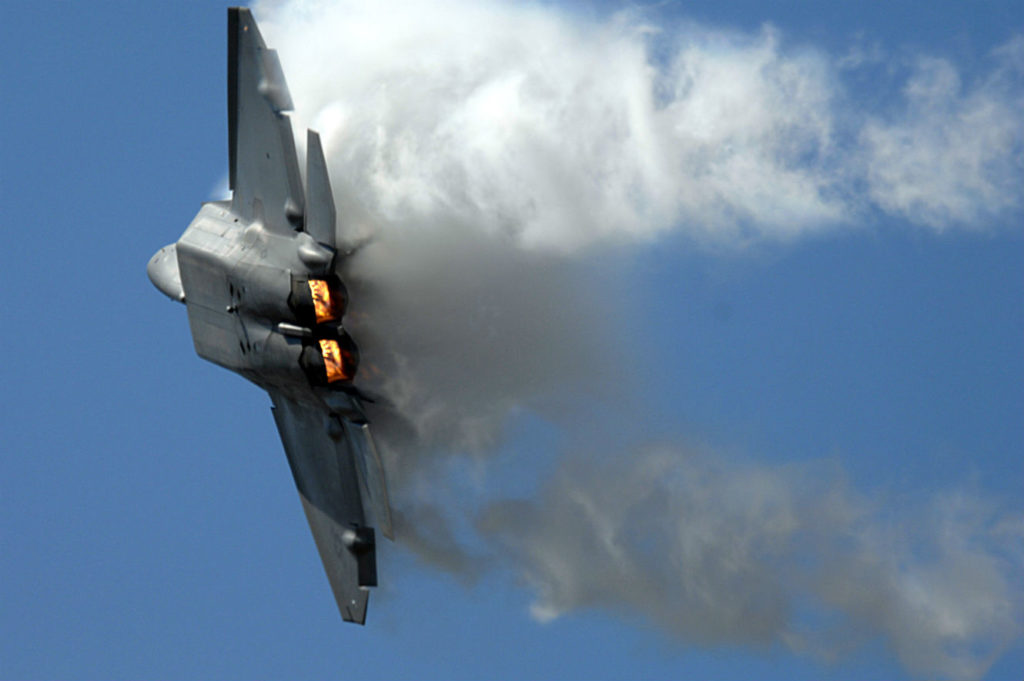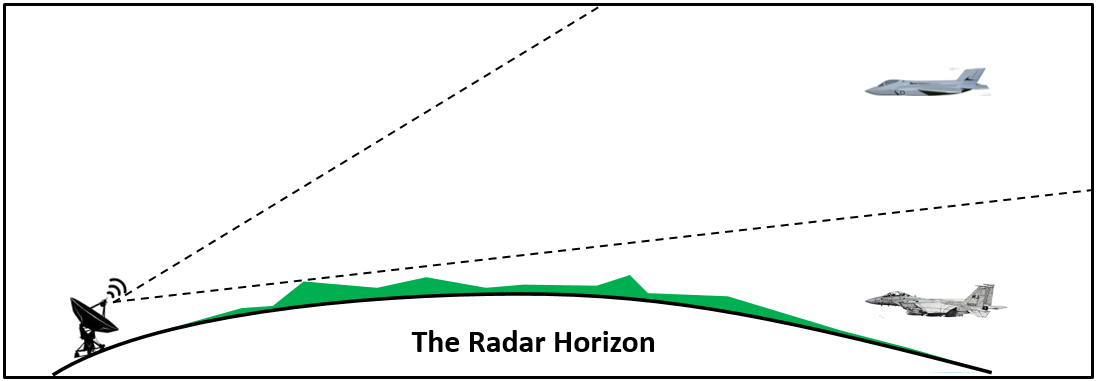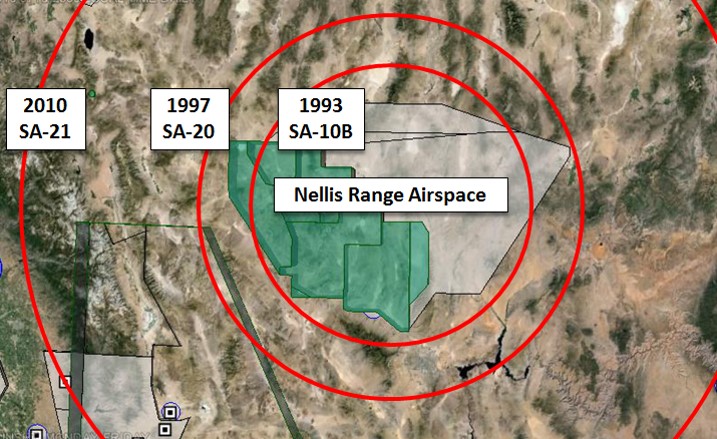Stealth is King, the World is Flat

Throughout history, American airmen have always sought to go over, not through, resistance to achieve victory — something today’s Air Force seems to have forgotten. The pursuit of an exquisite all-stealth force has diluted operations at the altitude extremes, relegating us to fight a flat war squarely in the “see me, shoot me, kill me” altitude block and placing the burden of survival on a rapidly diminishing technological advantage. Hope is not a tactic and surely not a strategy, but an overreliance on costly stealth is diminishing the long-term asymmetry of airpower. The U.S. Air Force must evolve the fight in the altitude extremes to go over and under, not through, resistance. This is however, easier said than done. It requires a clear understanding of the threat environment as it relates to the Air Force’s current capabilities, capacity, and resources. We can’t simply flip the switch and start doing low altitude again.
The Tyranny of Distance
Technology and globalization have fed both an evolution and proliferation of surface-to-air missile (SAM) systems that not only directly aim to counter stealth, but indirectly affect stealth by limiting the range from which the stealth platform can committed from. Two years after Desert Storm, Russia introduced the S-300 PMU (SA-10B) and its 81 NM 48N6 missile, doubling the engagement range over any previous system in the world and starting the era of “double digit SAMs.”* At that time, the Lockheed YF-22 had just won the Advanced Tactical Fighter competition, and the first developmental contract for the Joint Strike Fighter (F-35) had yet to be written. By 1997, the first F-22 test flight was met by the introduction S-300 PMU2 (SA-20) and 108 NM 48N6E2 missile, which increased engagement range by 33 percent. And in 2010, the year the F-35B first flew, Russia introduced the S-400 (SA-21), boasting a range of 215 nautical miles. As comparable theater ballistic missiles and anti-ship weapons were also fielded, “anti-access/area denial” entered the lexicon. Today, there are hundreds of these systems. Tomorrow, there will be many more. Going through this threat environment is not viable in the long term, given the stealthy F-35 will be flying until 2070. For the highest-end fight, interdiction and SEAD (suppression of enemy air defenses) missions should seek the extreme low ground, while counter-air missions should seek the extreme high ground.**
Why Go Low?
From the F-105s in Vietnam over Thud Ridge to the F-111s in Desert Storm, low-altitude flight served as a means of survival to get to and accurately hit the target. Almost every NATO country today qualifies their fighter pilots to 300 feet or less, except for the United States. A change in altitude from 1,000 feet to 500 feet reduces the radar horizon by 25 percent, but descending a bit lower to 300 feet reduces the radar horizon range an additional 25 percent. Hugging the ground also bestows further tactical benefits beyond the ability to exploit limited radar horizons.
The environmental realities of trees, rolling terrain, and buildings further decrease the probability of detection at lower altitudes. Flying in this radar noise-rich environment (“ground clutter”) with more terrain available to hide behind is essentially nature’s form of electronic attack — and it can’t be defeated. Finally, flying low to the ground significantly increases the line-of-sight rate imposed upon those systems trying to target aircraft — think of how fast you must turn your head to catch a low pass at an airshow. Imagine the difficulty in trying to target that aircraft. Despite the obvious tactical advantage of air operations at 300-feet, less than 15 percent of U.S. multi-role fighter pilots are qualified to fly that low, and a mere 5 percent hold a 100-feet qualification.
Why We Left
As Col. Pietrucha’s recent article describes, operating at low altitudes “is a perishable skill — aircrew must fly at low altitude routinely if they are to be kept current.” In Vietnam, the Air Force budgeted for all pilots to fly 20 hours per month. Through a series of budget cuts over the years, today’s pilots fly approximately 40 percent less than that F-105 pilot. From 2005 to 2012, the amount of budgeted flying hours was reduced by 46 percent — and that was before sequestration. That is not to say pilots are any less busy; quite the opposite.
Compared to 1991, the Air Force has 40 percent fewer aircraft and 43 percent fewer airmen, yet operational tempo has increased. The 90-day Air Expeditionary Force (AEF) deployments of the 1990s gave way to 120-day deployments in 2004 then expanded to 180-day rotations in 2010. While airmen are proud to support the mission, skillsets not used in these low-end, low-intensity conflicts are lost.
That said, an F-16 flying in 2016 cannot be compared to an F-16 that flew over Iraq in 1991. While Desert Storm reminds us of CNN images of precision air strikes, the reality is that guided munitions accounted for only 6.5 percent of all munitions employed in that war. Today, that number is around 98 percent. Advances in communication, networking, sensors, and weapons all necessitate more training time be devoted to a wider range of systems. Just as flying and multi-tasking don’t mix well, maintaining proficiency in a plethora of flying skillsets is likewise unrealistic. Combined with 25 consecutive years of perpetual deployments, currencies can be regained, but proficiency remains elusive.
Tyranny of Low Altitude
While the earth can be used to hide behind terrain, there will always be platforms that must remain more distant and at higher altitudes from threats; such as tankers and conventional command-and-control and surveillance aircraft. Thus, the range between the aircraft and target is increasingly more dependent on the distance between aerial refueling and the target. Combined with the growing tyranny of distance, this manifests a second-order tyranny of altitude.
As altitude decreases, the effective range of an aircraft also decreases because air density varies with altitude — this is why airliners fly high. Accordingly, mission planning systems reveal that an F-16 flying .7 Mach at 1,000 feet suffers a 58 percent decrease in combat radius versus flying at 30,000 feet. This important detail is surprisingly lacking in virtually all training and exercise scenarios today, including the pinnacle of air combat training: Exercise Red Flag. Ignoring today’s realities of distance and altitude, operators are lulled into developing tactics that may have little operational applicability.
Back to Our Roots
Historically, aircraft that were optimized (and successful) at low altitude were fighter-sized but not single seat. Such an aircraft should be fighter-sized and maneuverable to capitalize on terrain masking, possess integrated systems to permit day and night operations, and boast capabilities to protect itself from air and surface threats. Finally, this aircraft should have the fuel capacity to fly long ranges at low altitude and the ability to bear large payloads. This aircraft might sound expensive, but luckily for the taxpayer, this was bought and paid for back in the late 20th century: the fleet of 218 F-15Es in use today.
Unfortunately, the F-15E community has an identity crisis; another victim of a resource-constrained Air Force that has been pushed beyond doing more with less. Is the F-15E an air-to-air fighter that drops bombs or is the F-15E an interdiction platform that can perform self-protection at low and medium altitude? Low-altitude qualification, proficiency, and currency all require weight of effort and training focus, and it would be irresponsible to place aircrew in such an unforgiving flight regime without a sincere effort to be properly organized, trained, and equipped. Without this, low-altitude training will remain superficial.
Under Our Nose
While an aircraft capable of low-altitude interdiction remains in the inventory for now, what is lacking is a concerted effort to evolve low-altitude weapons. The stalwart of U.S. low-altitude weapons, the GBU-24 laser guided bomb, is a Cold War relic that should be retired. Low-altitude GPS-guided bomb lofts (a loaded G pull preceding weapons release) have made their ways into mainstream Air Force training of late, but this isn’t enough. Any target worth hitting is likewise worth defending, and Col. Pietrucha’s research provides this glaring revelation: If a weapon had existed during Vietnam or Desert Storm with a nominal 10 mile stand-off range, low-altitude employment survivability would have had a dramatically different score and perception today. Even better, the physics of radar horizon limitations means that this range will not change considerably any time soon.
Despite this, there exists a significant capability void in the U.S. weapons arsenal between a $25,000 JDAM (Joint Direct Attack Munition, a GPS-guided bomb) with a 5-mile attack range and a million-dollar stand-off weapon with a range of 200 miles or more. The medium-altitude Small Diameter Bomb (SDB) is the lone exemption with its nominal 40-mile range, but its employment is restricted to a benign medium-altitude release because it cannot be employed from low altitude.
The JDAM-ER is a winged variant of the venerable JDAM with a similar range and cost as the SDB, whose wing technology it employs. Due to a lack of U.S. interest, Australia shouldered development costs in 2009, and the weapon is now fully operational. The United States finally got a clue, but it will hopefully not end there. The more compelling part of this weapon is the potential: Boeing modeling shows it can be employed from a low-altitude loft profile, which opens a realm of new possibilities. Lofting a glide weapon garners a respectable stand-off range of 15 to 20 miles, which would presumably solve the low-altitude target area problem. Unfortunately, the Air Force has yet to define a requirement or even inquire about these possibilities. Buying this mature low-cost weapon with its unique capability seems like a no-brainer, but the Air Force continues to reach for expensive exquisite solutions to pedestrian problems.
Until the operational culture changes, the Air Force will continue to masquerade low-altitude training as operationally viable despite not being organized, trained, or equipped to make it so. Make no mistake, exploiting the extreme low-altitude environment will ensure long-term viable interdiction and survivability well beyond the shelf-life of medium altitude stealth. Let’s stop going through the problem and seek to fight in the extremes again.
Maj. Mike “Pako” Benitez is an F-15E Strike Eagle Weapons Systems Officer with over 2,000 flight hours, including 250+ combat missions in the Marine Corps and Air Force. A graduate of the US Air Force Weapons School and a former Defense Advanced Research Agency (DARPA) fellow, he is low altitude qualified to 100 feet in the F-15E (day and night). The views expressed are those of the author and do not necessarily reflect the official policy or position of the Department of the Air Force or the U.S. Government.
* “Double digit SAMs” are counter-air systems of extremely long range that have the ability to engage multiple targets simultaneously. The name comes from the sequential NATO naming convention and that fact that the first such system was designated the SA-10 (ten being the double-digit moniker). All such subsequent systems have double digit numbers (SA-12, SA-20, SA-21).
** “Counter-air” in this sense is literal (air-to-air). Doctrinally, this can definition can be expanded to include Suppression of Enemy Air Defenses (SEAD) or Offensive Counterair–Attack Operations (OCA-AO), both which are air-to-surface missions.
Image: U.S. Air Force Photo by Tech Sgt Justin D. Pyle

